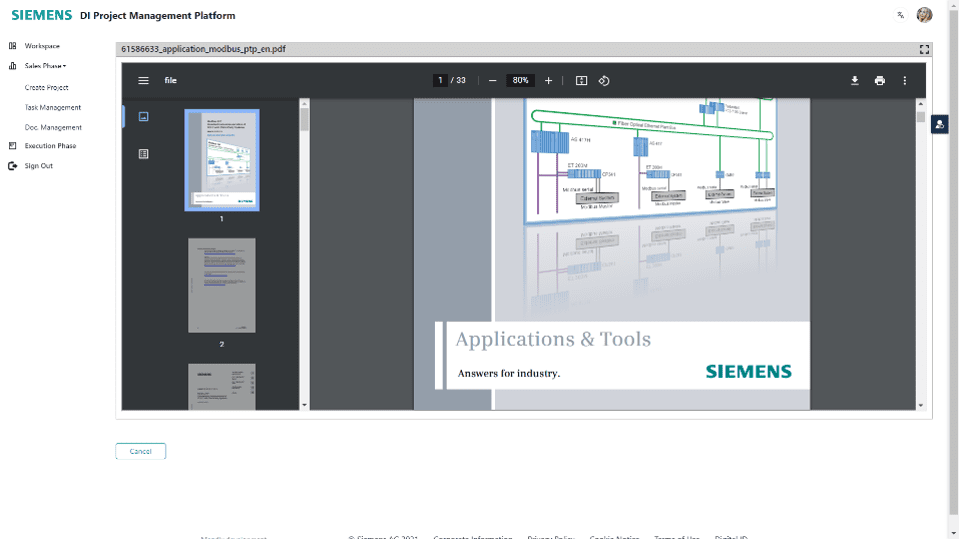Engineering Operations Center Transforms Project Management with Low-Code
Siemens Process Automation Division’s Engineering Operations Center (PA OEC) is a Siemens-owned engineering center rooted in a century of Siemens expertise.
With an international perspective on engineering execution, extensive technical knowledge, a professional engineering team, and rich domestic and international experience, it is a reliable partner in corporate transformation journeys.
The PA OEC team set out to address challenges across the organization, including:
- Numerous systems involved in project management
- Lack of transparency between systems
- Difficulty in data queries
- Error-prone and inefficient manual processes
- Low automation of data reporting
The PA OEC team developed the “SieProject” system using Mendix, achieving digital management of all project stages, eliminating manual processes, and enabling automated documentation and visualized dashboards.
Transparent, Flexible, and Efficient Operations
In the age of advanced smart manufacturing technologies such as digitalization and automation, PA OEC is dedicated to offering comprehensive solutions that integrate both technologies.
These solutions help clients achieve full-value chain digitalization by leveraging existing systems and equipment, tailoring implementations, and advancing digital transformation step-by-step. This approach:
- Enhances production stability, safety, flexibility, and efficiency
- Supports transparent, lean, and efficient management
- Quickly and effectively responds to customer-specific requirements
The PA OEC engineering team operates widely, centered in Shanghai and Xi’an, serving hundreds of process industry clients in chemicals, petrochemicals, glass, semiconductors, pharmaceuticals, food and beverage, water supply and treatment, cement, and more.
With over 200 engineers and project managers completing more than 2,000 engineering projects, the scale and breadth of their operations demand increasingly robust project management capabilities.
Operational management needs posed new challenges for the digitalization team. An initial analysis identified the main factors affecting data accuracy and efficiency: dispersed project data, low levels of automation, and cumbersome manual operations. Examples include:
- Project plans are managed in MS Project and uploaded as PDFs to a document management system, lacking integration with other systems.
- 13 systems cover processes such as project registration, bid planning, supplier pricing, purchase order approval, time tracking, logistics, project file archiving, and business data management, each used by different levels of personnel.
- Manual operations, like data uploads and updates, are prevalent, leading to potential errors and data inaccuracies.
“Using MS Project to manage schedules makes project statuses opaque. The multiple systems (13 in total) make data queries challenging. Some data is manually created or shared via email, leading to inefficiencies and errors. Project documents are stored as electronic files, limiting their usability,” said Xu Zhenyin, Head of Digital R&D and Internal Optimization.
Low-Code for Digital Transformation
In October 2021, through an internal Siemens email, the PA OEC team learned about Mendix. Inspired by IT and other departments’ success, they took action to digitally transform project management.
By December, the team held a consultation workshop involving consultants, department heads, and representatives from operations, quality, and procurement to strategize on cost reduction and competitiveness. The workshop highlighted key pain points and envisioned a blueprint for low-code digitalization.
By March 2022, the project team completed evaluations of Mendix and finalized the technical plan. Development began in May 2022, and by October, the project went live following trials and iterations.
Compared to traditional high-code development, which would require at least a year, low-code’s agility saved approximately 40% of time. Initial feedback showed SieProject improved efficiency by 10%-20% over previous manual management methods.
The new system, “SieProject,” digitally manages all project stages, including:
- Process Management: Transition from paper workflows to online workflow, customizable task templates, dynamic workflows based on form content, email notifications and approvals.

- Document Management: Shift from document-centric to task-centric management, convert folder-based structures to list-based structures, replace offline documents with online forms, automate template generation.

- Dashboard Management: One-stop PM data portal, integration with SAP HANA and SieEngineer, rich visualizations for presentations, coverage for departments like PMO, TS, ENG, QM, and FIN.

Four Key Benefits of Mendix
The OEC team identified four major benefits of Mendix in developing “SieProject”:
- Support for diverse architectures and application scenarios: Suitable for innovative, interactive, efficiency-enhancing, and core system integration applications.
- Agile DevOps: Enables iterative development, automated deployment, and data value extraction.
- Easy learning and use: Features like “Microflows,” “Domain Models,” and “User Interactions” accelerate development and allow business users to participate in maintenance.
- Rich interface and component ecosystem: 1,000+ public and private components for rapid integration with third-party systems like SAP and WeChat.
In the future, the OEC team plans to apply Mendix to broader areas, including internal processes, multi-user collaboration, industrial IoT projects, and Xcelerator-related digital product integration.